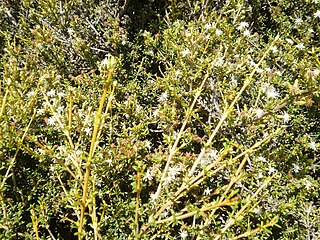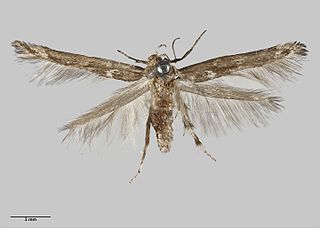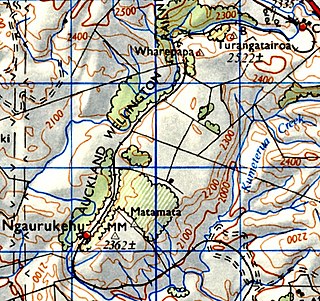
This article relates to the flora of New Zealand, especially indigenous strains. New Zealand's geographical isolation has meant the country has developed a unique variety of native flora. However, human migration has led to the importation of many other plants as well as widespread damage to the indigenous flora, especially after the advent of European colonisation, due to the combined efforts of farmers and specialised societies dedicated to importing European plants & animals.

Olearia, most commonly known as daisy-bush, is a genus of flowering plants belonging to the family Asteraceae, the largest of the flowering plant families in the world. Olearia are found in Australia, New Guinea and New Zealand. The genus includes herbaceous plants, shrubs and small trees. The latter are unusual among the Asteraceae and are called tree daisies in New Zealand. All bear the familiar daisy-like composite flowerheads in white, pink, mauve or purple.
The flora of the Chatham Islands consists of around 388 terrestrial plant species, of which 47 are endemic. The Chatham Islands make up the Chatham floristic province of the Neozeylandic Region of the Antarctic Kingdom.

Olearia hectorii is a species of flowering plant in the daisy family Asteraceae. Its common names include deciduous tree daisy and Hector's tree daisy. It is endemic to New Zealand, where it is nationally endangered.

Olearia traversiorum, the Chatham Island akeake, or Chatham Island tree daisy, is a species of flowering plant in the family Asteraceae. It is endemic to the Chatham Islands of New Zealand. It is also known by the synonym O. traversii.

Olearia colensoi, commonly known as tūpare or leatherwood, is a sub-alpine shrub that is endemic to New Zealand. Other names it is known by in Māori are kūmarahou and kūmararaunui.

Olearia rani, or heketara as it is known in Māori is a common small forest tree of New Zealand. It grows in lowland forest throughout the North Island and in the northern half of the South Island. Olearia rani var. rani has a more northern range than Olearia rani var. colorata which is found in forests from the Coromandel south to the Buller River. Its leaves have white undersides and prominent veins. During the spring the tree produces clusters of small white flowers.

Olearia arborescens, also known as common tree daisy and pekapeka by Māori, is a common shrub or small tree of New Zealand. It has also been called the Glossy Tree Daisy and the Forest Tree Daisy. It grows in lowland to alpine scrubland in the North Island from East Cape southwards, and throughout the South and Stewart Islands. Olearia arborescens was previously known as Solidago arborescens.

Olearia paniculata, commonly called akiraho, is a species of shrub or tree in the family Asteraceae, found only in New Zealand. The tree can grow to 6 metres high, and has yellow-green, oval-shaped leaves, with white undersides and wavy margins.

Olearia odorata, the scented tree daisy, is a small divaricating shrub endemic to New Zealand, from the plant family Asteraceae. It has small light green leaves with a large amount of interlacing twigs and grows to around 2–4m in height. In spring O. odorata produces many small white flowers.

Pasiphila cotinaea is a species of moth in the family Geometridae. It is endemic to New Zealand. Its larvae feed off Olearia species and the adult moth can be seen on the wing from November to April. This species is regarded as rare.

Olearia solandri, commonly known as coastal daisy-bush or coastal tree daisy, is a coastal shrub of New Zealand in the Asteraceae family.

Stathmopoda albimaculata is a species of moth in the Stathmopodidae family. It is endemic to New Zealand and is located in the lower half of the South Island. This species favours habitat that includes the various Olearia species that host its larvae. It has also been found to inhabit lowland podocarp native forest. The larvae feed on species in the genus Olearia. Adults are on the wing between the months of October and February. S. albimaculata is classified as Nationally Endangered by the Department of Conservation.

Stathmopoda campylocha is a species of moth in the family Stathmopodidae. It is endemic to New Zealand. It is classified as critically endangered by the Department of Conservation.
Olearia adenocarpa or small-leaved tree daisy is a small divaricating shrub endemic to New Zealand, from the plant family Asteraceae. The bush grows up to 1.5 metres in height and 1.2 m wide. It has a smaller and open growth habit in comparison to Olearia odorata. It is trailing deciduous to semi-deciduous.

Olearia avicenniifolia, known commonly as mountain akeake, is a flowering plant in the family Asteraceae. It is endemic to New Zealand where it is found on the southern coastlines of the South Island and on Stewart Island. It is classified as Not Threatened.

Meterana exquisita is a species of moth in the family Noctuidae. This species is endemic to New Zealand. It is classified as "At Risk, Relict'" by the Department of Conservation.

Aotea Conservation Park is a 12,300 hectare protected area on Great Barrier Island in New Zealand's Hauraki Gulf. It was established in 2015, and comprises 43 percent of the island.

Ngaurukehu, Ngarukehu, or Ngaurakehu, was a flag station on the North Island Main Trunk line, in the Ruapehu District of New Zealand. It is in the Hautapu River valley. It was 9.64 km (5.99 mi) north of Mataroa, 3.91 km (2.43 mi) south of Turangarere. Ngaurukehu is part way up a 1 in 70 gradient from Mataroa to Hīhītahi, so that it is 110 m (360 ft) above Mataroa and 62 m (203 ft) below Turangarere. It now has three passing loops.


















